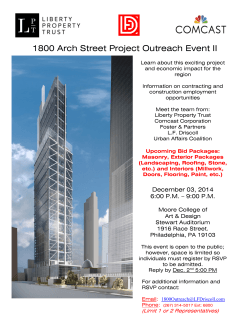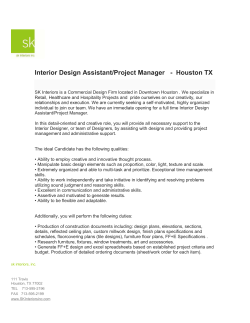
DecemberMMU - Material ConneXion
As part of our promise to provide our clients with the newest and most innovative materials sourced from around the world, we are pleased to present our monthly Materials Update. Here you will find the latest materials recently voted into our library through a jury selection process, which are now available on our database. These materials can be seen online and onsite at our New York location. Select materials are also available at our international locations; please call or email us at any of the addresses listed for more information. Interested in these materials but not a client? Our subscription-based Materials Library is the world’s largest library of advanced, innovative and sustainable materials and processes. With 30-40 new materials added every month, our libraries around the world give you immediate access to 7,500+ materials onsite and online, as well as Material Specialists and Monthly Updates on what’s new. Become a member of Material ConneXion today! To find out more about membership levels and benefits, contact us at: +1 212 842 2050 or access@materialconnexion.com Material ConneXion® New York. Bangkok. Daegu. Milan. Skövde. Tokyo. DecemberMMU Index carbon cement metal glass polymer ceramic process MC 2687-34 MC 2687-35 MC 2687-36 MC 2687-37 MC 3034-08 MC 3877-02 MC 5091-08 MC 5826-02 MC 5826-03 MC 5826-04 MC 5920-07 MC 5920-08 Wall covering material made of poly vinyl chloride (PVC) with numerous vertical striations imitating the appearance of raw silk. Applications include wall coverings for residential and commercial interiors. Flexible, handpainted, wood veneer decorated with bold organic patterns. It is backed with paper and can be wrapped on columns. Applications include wall coverings for residential and commercial interiors. Hardwood plywood made of renewable eucalyptus hybrid tree species. Applications include flooring, paneling, ceiling, furniture, cabinetry and tabletops. Transparent, compostable biopolymer film for bag applications. The film has a good balance of strength and stiffness, making it tough to tear or puncture. Wall covering comprising a cotton canvas covered with silver and gold leaf patterns. A protective topcoat is applied to make it more durable and scratch-resistant. Used in upholstered walls and ceilings. Formaldehyde- and phenol-free laminated decorative surface panels composed of recycled kraft paper and a bio-resin produced from sugar production waste. Applications include interior surfaces. Micro-beads of polyhydroxyalkanoates (PHA) that are fully biodegradable in marine environments. Applications include gentle exfoliants in personal care products such as shampoos and cleansers. Bio-based composite panel made from wood fiber (65%) and an acrylic binder (35%) that is formaldehyde free. Applications include tabletops, countertops, vanities, artwork, flooring, walls, partitions and furniture. natural Hand-dyed surfacing material composed of Kenaf strands. The material is hand-woven using traditional floor loom. Applications include wall coverings for residential and commercial interiors. Natural fiber based, high-stiffness composite laminate that has improved vibration-dampening properties. Used as rigid strengtheners in music instruments furniture, and sporting goods. Injection molding grade biopolymer for medium and large cavity molds that require high bio-content, biodegradability, or both. Used in disposable utensils, consumer products and electronics. Panels and planks that have been cut from discarded pine trees infested by blue stain fungus, each piece having a unique character and color. Used in tabletops, countertops, vanities, artwork and flooring. All material contained in this publication remains the property of Material ConneXion, Inc. and cannot be reproduced without express written permission. © 2014 Material ConneXion, Inc. Index carbon cement metal glass polymer ceramic process MC 6150-02 MC 6150-03 MC 6150-04 MC 6185-02 MC 6428-02 MC 6480-12 MC 6480-13 MC 6556-05 MC 6556-06 MC 6790-07 MC 6973-18 MC 7125-02 Bio-based composite material made from 50% flax fiber and 50% PP. Applications include automotive, electronic or industrial parts, garden and sports equipment or consumer products. Flexible, translucent sheets that are produced as a secretion from bacteria fed a sugary solution (in this case pineapple juice) in a warm bath. Applications include bags, upholstery and for accessories. Nonwoven felt composed of 50% natural fibers and 50% thermoplastic (PP). Applications include any composite part made by a thermocompression process. Leather made from equine caecum, i.e. horse intestine. The leather is made by vegetal tanning process and hence can be recycled. Applications include wall paneling, interiors and fashion. Bio-based insulation material made from natural grass cellulose (96%) and a boric acid fire retardant. Applications include blow-in insulation material for wall, roof and floor cavities. Additive comprising micro-sized platelets that contain cellulose nanofibers and are derived from the agricultural waste of root crops. Used in water-based resins, cosmetics, adhesives, plaster and paints. Structural sheet material that is an alternative to engineered wood, made from agricultural waste and mycelium. Applications include furniture components, sports equipment and architectural interiors. Pulp injection molded parts composed of 30% paper pulp, 30% starch, 30% water, the remaining ingredients a mixture of PVA and antimold. Used in semi-durable decorative products. natural Durable, composite material made of 75% natural fibers obtained from grass and 25% recycled PP for use in flooring. Applications include interiors, countertop, paneling and flooring. Reinforcement mat composed of 100% flax, which enables a higher fiber volume fraction compared with usual reinforcement mats (glass or natural fibers). Used in composite parts made by infusion or RTM. Packaging material made from mycelium (mushroom “roots”) and low value plant stalk fibers. Used in protective packaging, above-grade building insulation, consumer products, sports and protective gear. Prepreg composite made of unidirectional flax fibers or fabrics impregnated with epoxy resin to create a high strength, lightweight structure. Used in sporting goods, transportation, interiors and furniture. All material contained in this publication remains the property of Material ConneXion, Inc. and cannot be reproduced without express written permission. © 2014 Material ConneXion, Inc. Index carbon cement metal glass polymer ceramic process MC 7295-06 MC 7332-01 MC 7333-01 MC 7334-01 MC 7335-01 MC 7336-01 MC 7337-01 MC 7339-01 MC 7341-01 MC 7342-01 MC 7343-01 MC 7344-01 Biopolymer filament composed of 80% PLA and 20% recycled bamboo fibers, a rapidly renewable resource. Applications include the additive manufacturing of toys, novelties and jewelry. High-performance closed-cell foam that is a replacement for neoprene, PU, and EVA. Applications include wetsuits, toys, footwear, sports apparel, protection equipment, yoga mats and gasketing. Flax (linen) fiber treated with an enzymatic process to produce soft, fine fibers comparable to cotton making it suitable for knitting as well as weaving. Used for underwear, apparel and furnishings. Insulating material that is composed of seaweed (posidonia oceanica). Applications include insulation of internal or external walls, ceilings and panels. PHA polymer produced through the microbial fermentation of sugars. Applications include packaging, bags, containers, housewares, lighting, textiles, vehicles and electronics. Polyhydroxyalkanoate (PHA) polymer, a linear polyester produced through the microbial fermentation of sugars. Applications include packaging, bags, containers, lighting, textiles, vehicles and electronics. Resin compound composed of aquatic algae biomass. Applications include disposable packaging containers, consumer goods and horticultural films. Prefabricated construction bricks produced from natural Beton, a bio-compound made from a mixture of 35% Canabium (hemp) and 65% natural lime binder.Used in walling systems and partitions. natural Moldable fibrous pulp that contains a mix of rapidly renewable grasses and fibers, including bulrush, bagasse, bamboo, wheat stalk and kenaf. Applications include consumer product and food packaging. Cellulose kraft pulp from planted eucalyptus trees. Eucalyptus is fast growing, increasing the rate and volume of harvest. The pulp is suitable for use in absorbent articles and paper products. Virgin-fiber based board coated with bioplastic. Applications include packaging of chilled food, fast food, ice cream, cups for cold drinks, confectionery and pastries. Lumber that has been treated with silica to ‘mineralize’ the natural cells of the wood and create an impervious barrier. It is used for construction of houses, as well as for decking, and poles and studs in buildings. All material contained in this publication remains the property of Material ConneXion, Inc. and cannot be reproduced without express written permission. © 2014 Material ConneXion, Inc. Index carbon cement metal glass polymer ceramic process MC 7345-01 MC 7346-01 MC 7347-01 MC 7348-01 MC 7350-01 MC 7350-02 High-performance, bio-based paint and primer whose precursors are derived from soy. Applications include interior and exterior use for drywall, fiber cement, masonry, concrete, wood and most primed metals. Leather-like paper created from 70% silkworm cocoon fibers and 30% honeybee bio resin, both insect waste materials. Applications include furniture, fashion and surface design. High-performance prepreg that contains flax fibers and resin for a total of 75% bio-based content. Applications include sports equipment, musical instruments, furniture and consumer electronics. Carpet tiles made from carded Cashmere goat hair fibers (70%) and nylon (30%) formed into a continuous corrugation and bonded to a (PVC) backing. Used in commercial and residential interiors. natural Biodegradable packaging material made from Sorghum grain protein. Applications include packaging for electronics, glass and other fragile materials. Carpet roll made from carded Cashmere goat hair fibers (80%), 15% Nylon, 5% Viscose (Rayon). Applications include commercial and residential interiors. All material contained in this publication remains the property of Material ConneXion, Inc. and cannot be reproduced without express written permission. © 2014 Material ConneXion, Inc. Andrew H. Dent, PhD VP Library and Materials Research Material ConneXion® T +1 917 934 2895 E adent@materialconnexion.com w materialconnexion.com Chompoonuj Weerakitti Director Library and Materials Research Material ConneXion® Bangkok T +66 (0) 2 664 8448 E cweerakitti@materialconnexion.com w materialconnexion.com/th Sun Ah Kim Director Library and Consulting Material ConneXion® Daegu T +82 53 740 0033 E sakim@materialconnexion.com w materialconnexion.com/kr Micol Costi Director Library and Materials Research Material ConneXion® Italia T +39 02 36553060/36553169 E mcosti@materialconnexion.com w materialconnexion.com/it Anders Brietholtz Managing Director Material ConneXion® Skövde T +46 (0) 500 50 25 00 E abrietholtz@materialconnexion.com w se.materialconnexion.com A SANDOW Company 1271 Avenue of the Americas 17th Floor New York, NY 10020 T +1 212 842 2050 F +1 212 842 1090 Kumiko Yoshikawa Chief Operating Officer Material ConneXion® Tokyo T +81 (0) 3 6721 1780 E kyoshikawa@materialconnexion.com w materialconnexion.com/it materialconnexion.com All material contained in this publication remains the property of Material ConneXion, Inc. and cannot be reproduced without express written permission. © 2014 Material ConneXion, Inc.
© Copyright 2025










